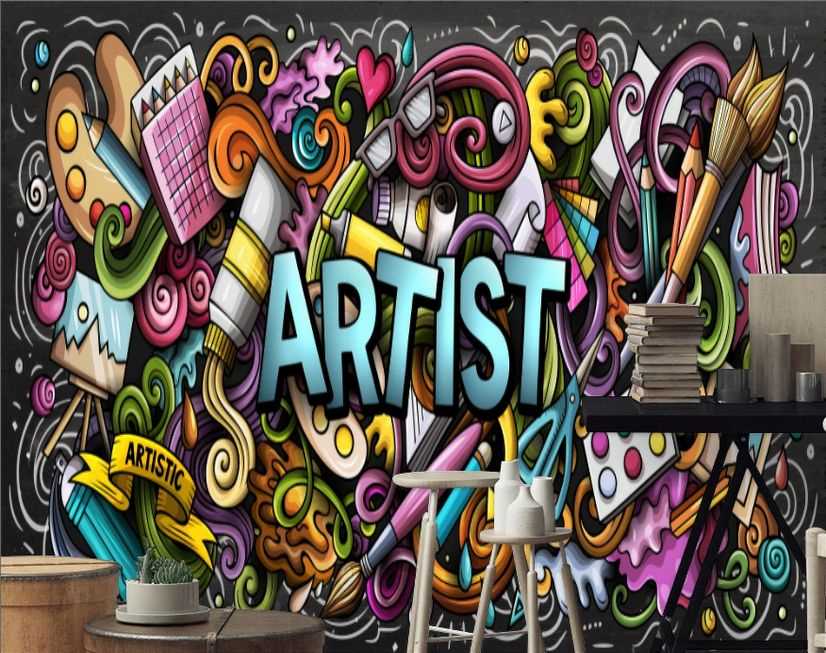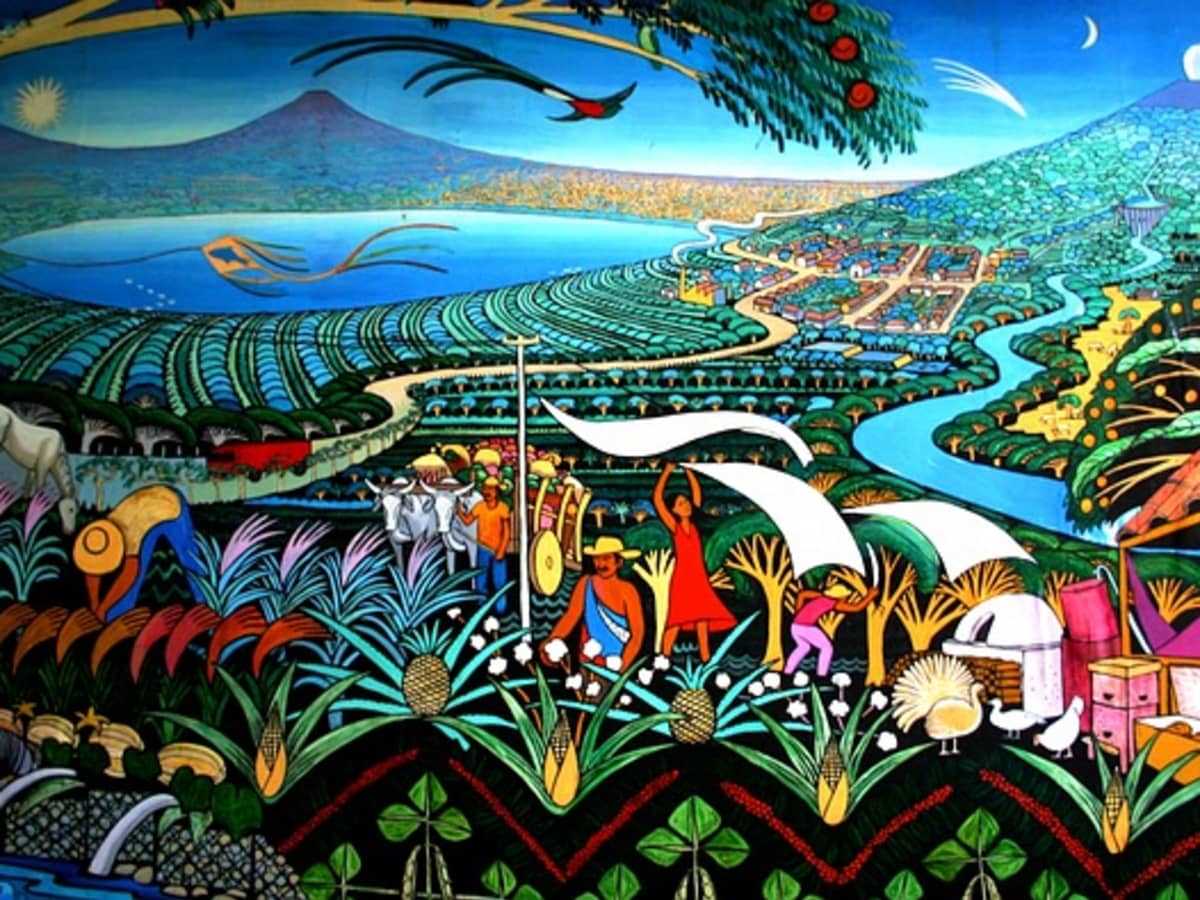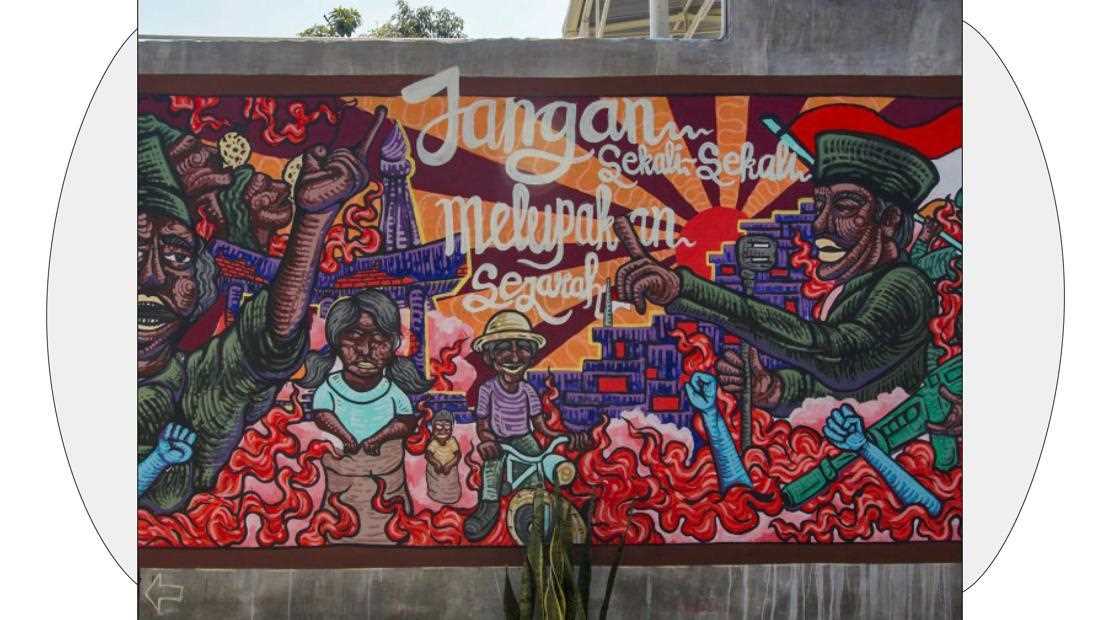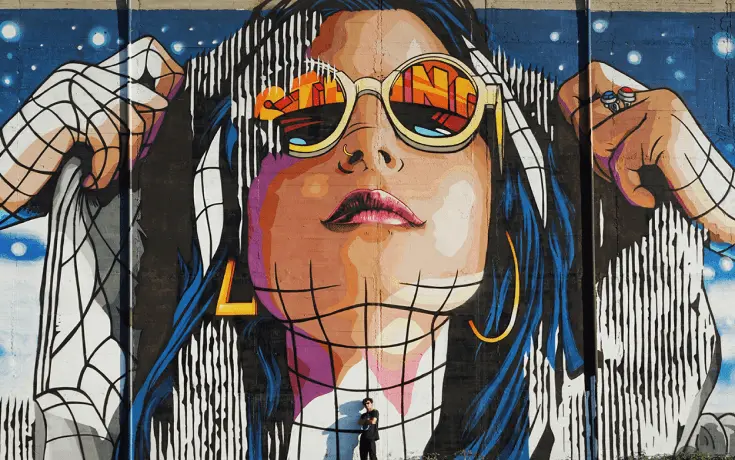
Mural drawing is a captivating and powerful form of artistic expression that has been used for centuries to adorn walls and tell stories. It is an art form that brings together creativity, skill, and a deep appreciation for the power of public art. Murals can be found on the sides of buildings, in public spaces, and even inside homes, transforming ordinary spaces into vibrant, visually stunning works of art.
Creating a mural is a labor of love that requires careful planning, attention to detail, and a strong vision. From the initial concept to the final brushstroke, mural artists have to think about composition, color theory, and the overall impact the artwork will have on its surroundings. They must also consider the message or story they want to convey and how to engage viewers on an emotional and intellectual level. The process of mural drawing is not just about creating visually appealing images but also about creating a connection with the community and stimulating dialogue.
One of the unique aspects of mural drawing is its ability to transform public spaces and bring art to people who may not have the opportunity to visit a traditional gallery or museum. Murals have the power to inspire, provoke thought, and make a statement. They can capture the history and culture of a place, celebrate diversity, promote social change, or simply beautify a neighborhood. By taking art to the streets and making it accessible to all, mural drawing has the potential to create a sense of pride and unity within a community.
Whether bold and colorful, or subtle and thought-provoking, murals have the ability to make a lasting impression. The art of mural drawing continues to evolve and push boundaries as artists experiment with new techniques, materials, and styles. From the iconic works of street artists to the breathtaking murals that grace the walls of museums and galleries, this art form continues to captivate and inspire audiences around the world.
History of Mural Art
Mural art has a rich history that spans across different cultures and time periods. The origins of mural painting can be traced back to ancient civilizations such as Egypt, Mesopotamia, and India. These early civilizations used murals to depict their daily lives, beliefs, and myths.
During the Renaissance period in Europe, mural painting reached its peak. Artists like Michelangelo and Raphael used murals to decorate the walls and ceilings of churches and palaces. These grand-scale paintings showcased religious and historical scenes, making them an essential form of visual storytelling.
In the 20th century, mural art evolved into a platform for social and political expression. The Mexican muralist movement, led by artists like Diego Rivera, used murals to depict the struggles of the working class and to promote social justice. These murals became powerful symbols of resistance and unity.
Influence of Mural Art
Mural art has had a profound influence on society and the art world. It has the ability to transform public spaces, making them more vibrant and engaging. Murals have the power to communicate a strong message and reflect the values and culture of a community.
Mural art is not confined to traditional mediums like paint and brushes. With the advancement of technology, artists now experiment with various materials and techniques. Digital murals, 3D murals, and interactive murals are gaining popularity, pushing the boundaries of mural art.
The Future of Mural Art
The future of mural art holds endless possibilities. Artists continuously find innovative ways to create captivating and thought-provoking murals. This art form will continue to evolve and adapt to the changing times, serving as a platform for self-expression and community engagement.
Street Art and Mural Painting
Street art and mural painting have become increasingly popular forms of artistic expression in urban spaces. These art forms can transform the dull and mundane aspects of a city into vibrant and engaging spaces.
Street art often refers to unsanctioned artwork which is created in public spaces, such as walls, sidewalks, and buildings. It is typically characterized by bold graphics, intricate designs, and powerful messages. Street artists often use spray paint, stencils, and other materials to create their works. This art form emerged as a form of rebellion and a way for artists to make their voices heard outside of mainstream art institutions.
Mural painting, on the other hand, is a more traditional form of art that has been practiced for centuries. Murals can be found in ancient civilizations as well as in modern urban settings. Unlike street art, mural painting is often commissioned and completed with the approval of the community or property owner. Murals can cover entire walls or buildings, and can depict a wide range of subjects, from historical events to social commentary.
Both street art and mural painting have the power to create a sense of community and identity. They can spark conversations, challenge the status quo, and inspire change. These art forms allow artists to engage with their surroundings and convey messages that may otherwise go unnoticed. Street art and mural painting have the ability to turn public spaces into open-air museums, accessible to all.
| Street Art | Mural Painting |
|---|---|
| Unsanctioned artwork | Commissioned artwork |
| Rebellion and self-expression | Community approval |
| Bold graphics and messages | Wide range of subjects |
| Transforms urban spaces | Creates community identity |
The Process of Mural Design
Designing a mural is a creative and iterative process that involves several steps. From initial concept to final execution, mural designers carefully plan and organize their ideas to bring their vision to life. Below, we outline the typical process of mural design:
| 1. Inspiration and Research | The first step in the design process is finding inspiration and conducting research. Mural designers gather ideas by exploring different art styles, studying historical murals, and learning about the intended audience and location of the mural. |
| 2. Concept Development | Once designers have gathered inspiration, they start developing their concepts. This involves brainstorming ideas, sketching rough drafts, and reflecting on the intended message and theme of the mural. |
| 3. Composition and Layout | Next, designers focus on creating a strong composition and layout for the mural. They consider factors such as scale, balance, and focal points, ensuring that the design will be visually striking and harmonious in its intended environment. |
| 4. Color Palette and Materials | Choosing the right color palette and materials is crucial in mural design. Designers consider the mood and atmosphere they want to create, as well as the durability and longevity of the mural. They experiment with different colors and materials to find the perfect combination for their design. |
| 5. Approval and Feedback | Before beginning the final execution, mural designers often seek approval and feedback from clients or stakeholders. They present their design concept and address any concerns or suggestions to ensure everyone is aligned and satisfied with the proposed mural. |
| 6. Execution | Once the design is approved, mural designers begin the execution phase. They carefully transfer their design onto the mural surface, using techniques such as freehand drawing or projection. This stage requires attention to detail and precision to bring the design to life. |
| 7. Finishing Touches and Maintenance | After completing the mural, designers add any necessary finishing touches, such as protective coatings or touch-ups. They also consider the maintenance requirements of the mural to ensure its longevity, providing clients with recommendations for cleaning and upkeep. |
Overall, the process of mural design is a blend of creativity, research, and technical skill. From inspiration to execution, mural designers carefully plan each stage to create impactful and visually stunning artworks that enrich their surroundings.
Choosing the Right Wall for a Mural
When it comes to creating a mural, choosing the right wall is critical. The wall you select will have a significant impact on the overall appearance and longevity of your artwork. Here are a few factors to consider when choosing a wall:
Surface Condition: Ensure that the wall is in good condition and free of any major imperfections such as cracks or peeling paint. A smooth and clean surface will make it easier to apply the mural and ensure a better end result.
Location: Consider the location of the wall and how it will affect the visibility of your mural. Walls that are visible from a distance or in high-traffic areas are ideal, as they offer more exposure for your artwork.
Size: The size of the wall should be appropriate for the scale of your mural. Large walls provide more space for elaborate and intricate designs, while smaller walls may require simpler compositions.
Accessibility: Make sure the wall is easily accessible for you to work on. Consider factors such as height, proximity to other structures, and any obstacles that may hinder your ability to paint the mural.
Surface Compatibility: Different mural techniques require different wall surfaces. For example, porous surfaces like brick or concrete may require additional preparation or sealing before painting. Research the specific techniques and materials you plan to use to ensure they are compatible with the chosen wall.
Owner Permission: Before starting a mural, always obtain permission from the owner of the wall. This ensures that you have legal rights to paint the wall and helps build positive relationships within the community.
By considering these factors and choosing the right wall, you can set yourself up for a successful and visually appealing mural that will enhance the space and captivate viewers.
Essential Tools for Mural Drawing
Creating a mural requires a range of tools to ensure that the artist can achieve their desired vision. Whether you are a professional mural artist or an enthusiastic beginner, having the right tools is essential for a successful mural project. Here are some essential tools that every mural artist should have:
1. Paint Brushes
Having a variety of paint brushes is crucial for mural drawing. Different brushes can create different effects and textures, so it is important to have a selection of brushes in various sizes and shapes. Flat brushes are great for creating large areas, while round brushes are ideal for adding details.
2. Paint Rollers
In addition to brushes, paint rollers are useful for covering large areas of the mural quickly and efficiently. They are particularly handy for background painting and for applying base coats.
3. Acrylic Paint

Acrylic paint is a popular choice for mural artists due to its versatility and durability. It dries quickly and is suitable for indoor and outdoor murals. Make sure to have a variety of colors and shades to bring your mural to life.
4. Spray Paint

Spray paint is another essential tool for mural drawing, especially when creating graffiti-style murals or adding intricate details. It allows for smooth application and can be used to create gradients and stenciled designs.
5. Pencils and Markers
Sketching out your mural design beforehand is essential for planning and mapping out your artwork. Pencils and markers are great for outlining and drawing initial sketches before adding paint.
6. Ladders and Scaffolding

Murals often require working at heights, so having access to ladders or scaffolding is crucial for reaching higher areas of the wall. Safety should always be a top priority, so make sure to use these tools in a secure and stable manner.
7. Sealant
Once your mural is complete, applying a sealant is important to protect it from weather conditions and fading. There are various sealants available that are suitable for different surfaces, so make sure to choose one that is compatible with the wall material.
These are just a few of the essential tools that mural artists should have in their arsenal. Remember, the key is to choose high-quality tools that suit your style and the requirements of your mural project. With the right tools and a creative vision, you can bring your mural ideas to life!
Colorful Techniques in Mural Art

Murals are a vibrant and visually striking form of art that can transform a space and evoke emotions. One of the key elements of creating an impactful mural is the use of color. Here are some colorful techniques commonly used in mural art:
1. Gradient Blending: This technique involves blending different shades of the same color or multiple colors together, creating a smooth transition between them. Gradient blending adds depth and dimension to a mural, giving it a realistic and dynamic appearance.
2. Mosaic: Mosaic murals utilize small, colorful tiles or pieces of glass or ceramic to create intricate patterns, designs, or images. The use of a wide range of vibrant colors in mosaics can result in visually stunning and detailed murals.
3. Stenciling: Stenciling is a technique that involves using pre-cut stencils to apply different colors to a mural. This technique allows for precise and clean lines, creating a bold and graphic effect. Stenciling can be used to create geometric shapes, intricate patterns, and even realistic images.
4. Trompe-l’oeil: Trompe-l’oeil, meaning “deceive the eye” in French, is a technique that gives the illusion of three-dimensional objects or scenes. By using shading, perspective, and realistic color rendering, trompe-l’oeil murals create an optical illusion that blurs the line between art and reality.
5. Sgraffito: Sgraffito is a technique that involves layering different colors of plaster or paint and then scratching the surface to reveal the colors beneath. This technique adds texture and depth to the mural, creating an interesting and visually captivating effect.
These colorful techniques in mural art offer artists a wide range of options to play with, allowing them to bring their creative visions to life and captivate viewers with their vibrant and dynamic creations. Whether it’s through blending colors, using intricate mosaics, or creating optical illusions, color plays a crucial role in making murals come alive.
Graffiti and Mural Art

Graffiti and mural art are closely related art forms that have gained popularity in recent years. While they may seem similar on the surface, there are distinct differences between the two.
Graffiti

Graffiti is often associated with street art and vandalism. It typically involves the use of spray paint or markers to create illegal markings on public or private property. Graffiti artists often tag their names or use recognizable symbols to leave their mark.
Graffiti can be seen as a form of self-expression and a way for artists to claim their territory. It can also serve as a political or social commentary, addressing issues such as inequality, injustice, and oppression.
Mural Art

Mural art, on the other hand, is a more legal and accepted form of public art. It involves creating large-scale paintings or designs on walls, buildings, or other structures. Mural artists often work in collaboration with communities, organizations, or property owners to create art that reflects the local culture, history, or aspirations.
Mural art can beautify and transform urban spaces, turning plain walls into vibrant works of art. It has the power to engage and inspire viewers, fostering a sense of pride and identity within a community.
While graffiti and mural art share some similarities, such as the use of public space as a canvas and the desire to create visually striking images, they differ in terms of legality, intent, and audience reception.
Both graffiti and mural art can be powerful forms of artistic expression, showcasing the creativity, skill, and individuality of the artists involved.
Famous Mural Artists

Throughout history, there have been many talented artists who have left their mark on the world through their incredible mural creations. These artists have not only brought beauty to the walls of buildings, but have also used their art to tell stories, convey messages, and inspire viewers. Here are some of the most famous mural artists:
- Diego Rivera: A Mexican painter known for his large-scale murals that depict Mexico’s history and social issues. His work often focused on the struggles of the working class and indigenous people.
- David Alfaro Siqueiros: Another prominent Mexican muralist who was a close associate of Diego Rivera. Siqueiros’s murals often portrayed revolutionary themes and political messages.
- José Clemente Orozco: Yet another influential Mexican muralist, Orozco was known for his powerful and dramatic murals that explored themes of human suffering and the struggles of the working class.
- Frida Kahlo: Although primarily known for her self-portraits, Frida Kahlo also dabbled in mural painting. Her murals showcased her personal experiences and struggles, often incorporating elements of surrealism.
- Pablo Picasso: One of the most renowned artists of all time, Picasso also experimented with mural painting. His murals often featured abstract and cubist designs, reflecting his innovative approach to art.
- Keith Haring: A contemporary American artist, Haring is known for his iconic murals that feature bold lines and vibrant colors. His work often tackled social and political issues, making a powerful impact on the public.
- Banksy: An anonymous graffiti artist and political activist, Banksy has gained worldwide recognition for his thought-provoking mural art. His work often carries a strong social or political commentary, challenging the status quo.
These are just a few examples of the countless talented mural artists who have made a lasting impact on the art world. Their works continue to inspire and captivate audiences around the world, reminding us of the power of art to convey meaningful messages and create a lasting impression.
Inspiration for Your Mural

When it comes to creating a mural, finding inspiration is essential to ensure a captivating and meaningful artwork. Here are some great sources of inspiration to help you get started:
Nature: The world around us offers a plethora of beauty that can be translated into stunning murals. From majestic landscapes to delicate flowers, nature provides endless inspiration. Take a walk in the park or immerse yourself in the wilderness to observe the colors, textures, and patterns that can be incorporated into your mural.
History and Culture: Delving into the rich history and diverse cultures of different countries can open up a whole new world of inspiration. Ancient civilizations, traditional art forms, and historical events can all be represented in your mural, adding depth and meaning to your artwork.
Personal Experiences: Your own experiences and emotions can serve as the foundation for a truly personal and impactful mural. Reflecting on important moments, cherished memories, or even challenges you’ve overcome can bring a unique perspective to your artwork and create a powerful connection with viewers.
Artwork and Artists: Studying the works of renowned artists can be a great way to find inspiration and learn new techniques. Take a trip to a museum or browse through art books to discover different styles, color schemes, and composition ideas that could be incorporated into your mural.
Community and Local Culture: Paying homage to your community and its unique characteristics can create a mural that resonates with the people who live there. Research local landmarks, traditions, or even influential figures to incorporate elements that will make your mural a true reflection of the community.
Social Issues: Murals have long been used as a platform for social commentary and activism. Addressing important social issues through your artwork can have a profound impact on viewers and spark meaningful conversations. Choose a cause close to your heart and let your mural become a powerful voice for change.
Imagination and Dreams: The beauty of murals lies in their ability to transport viewers to different worlds and evoke emotions. Let your imagination run wild and create a mural that captures dreams, fantasies, or surreal landscapes. Push the boundaries of reality to create a truly captivating artwork.
Remember, inspiration can come from anywhere – it’s all about opening your eyes and embracing the world around you. Allow these sources of inspiration to fuel your creativity and bring your mural to life.

I am a mural enthusiast and a fervent admirer of street art. Rather than creating murals myself, I am passionate about collecting them. My love for street art knows no bounds. I am dedicated to curating and cherishing these artworks that grace the streets. My collection stands as a testament to my profound appreciation for this form of artistic expression.
read about me



